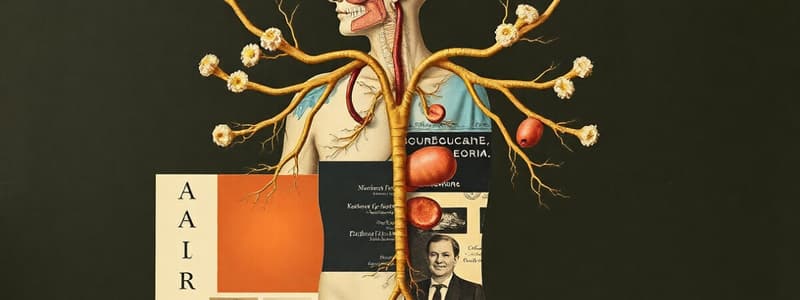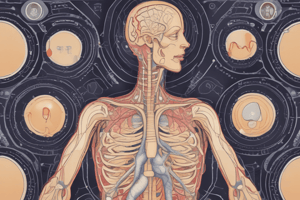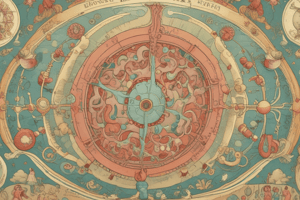Podcast
Questions and Answers
What is the endocrine system?
What is the endocrine system?
The endocrine system is a collection of glands that produce and secrete hormones into the bloodstream.
The endocrine system is a system of ductless glands that secrete hormones.
The endocrine system is a system of ductless glands that secrete hormones.
True (A)
What is the name of the gland that is often referred to as the 'master gland'?
What is the name of the gland that is often referred to as the 'master gland'?
- Pituitary gland (correct)
- Adrenal gland
- Pineal gland
- Thyroid gland
What are hormones?
What are hormones?
How do hormones act on target cells?
How do hormones act on target cells?
Which of the following is NOT a mechanism of hormone release?
Which of the following is NOT a mechanism of hormone release?
The endocrine system comprises the ______ and ______ endocrine organs.
The endocrine system comprises the ______ and ______ endocrine organs.
What is the role of the endocrine system?
What is the role of the endocrine system?
Endocrine glands are ductless glands.
Endocrine glands are ductless glands.
Which of the following are examples of hormones produced by the body? (Select all that apply)
Which of the following are examples of hormones produced by the body? (Select all that apply)
Explain how hormones interact with target cells.
Explain how hormones interact with target cells.
What are the two main types of feedback mechanisms in the endocrine system?
What are the two main types of feedback mechanisms in the endocrine system?
What is the significance of the hypothalamus-pituitary axis?
What is the significance of the hypothalamus-pituitary axis?
Which is a type of hormone that is stored in vesicles in endocrine cells?
Which is a type of hormone that is stored in vesicles in endocrine cells?
What is the function of the thyroid gland?
What is the function of the thyroid gland?
Calcitonin is secreted by the parathyroid glands.
Calcitonin is secreted by the parathyroid glands.
What is the primary function of parathyroid hormone (PTH)?
What is the primary function of parathyroid hormone (PTH)?
What are the two major components of the adrenal gland?
What are the two major components of the adrenal gland?
Which hormone is responsible for regulating blood pressure?
Which hormone is responsible for regulating blood pressure?
What is Cushing's syndrome, and what causes it?
What is Cushing's syndrome, and what causes it?
What is Addison's disease, and what are its main features?
What is Addison's disease, and what are its main features?
What type of receptor do lipophilic hormones typically activate?
What type of receptor do lipophilic hormones typically activate?
Which hormone is primarily responsible for promoting breast milk production?
Which hormone is primarily responsible for promoting breast milk production?
What is the primary function of thyroxine in the body?
What is the primary function of thyroxine in the body?
How does parathyroid hormone primarily affect the body's calcium levels?
How does parathyroid hormone primarily affect the body's calcium levels?
Which of the following glands is involved in the production of thyroid hormones?
Which of the following glands is involved in the production of thyroid hormones?
What is the physiological effect of oxytocin on the body?
What is the physiological effect of oxytocin on the body?
What is the nature of hormones that are classified as hydrophilic?
What is the nature of hormones that are classified as hydrophilic?
Which type of hormone is likely to be stored in vesicles before being released?
Which type of hormone is likely to be stored in vesicles before being released?
Flashcards
Thyroxine
Thyroxine
A hormone produced by the thyroid gland, crucial for metabolism.
Hydrophilic hormones
Hydrophilic hormones
Water-soluble hormones that can travel freely in the bloodstream.
Lipophilic hormones
Lipophilic hormones
Fat-soluble hormones that need carriers for transport in the bloodstream.
Intracellular receptors
Intracellular receptors
Signup and view all the flashcards
Oxytocin
Oxytocin
Signup and view all the flashcards
Posterior pituitary
Posterior pituitary
Signup and view all the flashcards
Anterior pituitary
Anterior pituitary
Signup and view all the flashcards
Tropic hormones
Tropic hormones
Signup and view all the flashcards
Thyroid-stimulating hormone (TSH)
Thyroid-stimulating hormone (TSH)
Signup and view all the flashcards
Kidney
Kidney
Signup and view all the flashcards
Nephron
Nephron
Signup and view all the flashcards
Diluted Urine
Diluted Urine
Signup and view all the flashcards
Tyrosine
Tyrosine
Signup and view all the flashcards
Hyperplasia
Hyperplasia
Signup and view all the flashcards
Hypertrophy
Hypertrophy
Signup and view all the flashcards
Negative feedback
Negative feedback
Signup and view all the flashcards
Zona glomerulosa
Zona glomerulosa
Signup and view all the flashcards
Zona fasciculata
Zona fasciculata
Signup and view all the flashcards
Adrenocorticotropic hormone (ACTH)
Adrenocorticotropic hormone (ACTH)
Signup and view all the flashcards
Aldosterone
Aldosterone
Signup and view all the flashcards
Cortisol
Cortisol
Signup and view all the flashcards
Blood glucose
Blood glucose
Signup and view all the flashcards
TSH function
TSH function
Signup and view all the flashcards
Thyroxine effect on metabolism
Thyroxine effect on metabolism
Signup and view all the flashcards
Hypothalamus-Pituitary-Thyroid (HPT) axis
Hypothalamus-Pituitary-Thyroid (HPT) axis
Signup and view all the flashcards
Low TSH levels
Low TSH levels
Signup and view all the flashcards
High TSH levels
High TSH levels
Signup and view all the flashcards
Thyroid hormones and energy
Thyroid hormones and energy
Signup and view all the flashcards
Hyperthyroidism symptoms
Hyperthyroidism symptoms
Signup and view all the flashcards
Hypothyroidism symptoms
Hypothyroidism symptoms
Signup and view all the flashcards
Pituitary gland
Pituitary gland
Signup and view all the flashcards
What are the two main parts of the pituitary gland?
What are the two main parts of the pituitary gland?
Signup and view all the flashcards
What do tropic hormones do?
What do tropic hormones do?
Signup and view all the flashcards
TSH
TSH
Signup and view all the flashcards
How does thyroxine affect metabolism?
How does thyroxine affect metabolism?
Signup and view all the flashcards
Hyperthyroidism
Hyperthyroidism
Signup and view all the flashcards
Hypothyroidism
Hypothyroidism
Signup and view all the flashcards
Study Notes
The Endocrine System
- The endocrine system is a system of ductless glands that secrete hormones directly into the bloodstream.
- These hormones act as chemical messengers, controlling a wide range of physiological processes.
- Organs like the pancreas also secrete hormones in addition to other functions.
Components of the Endocrine System
- Endocrine glands: Produce and secrete hormones.
- Hormones: Chemical messengers that regulate bodily functions.
Endocrine Glands
- Ductless glands composed of endocrine cells.
- Do not have ducts that lead to the outside of the body.
- Secrete hormones directly into the bloodstream.
Hormones
- Organic chemical messengers produced by endocrine cells.
- Secreted into the bloodstream that circulate throughout the body.
- Act on distant target cells (i.e. remote communication)
- Activate specific responses in targeted cells, and not in all cells.
- Activation is dependent on specific receptor binding.
- There are three primary hormone types: peptide, amino acid derivatives, and steroid.
- Can function as paracrine or autocrine regulators (where the hormones do not travel in the blood).
- Their effects on the target cells depend on the programmed response of the target cells.
Hormone Receptors
- Found on the target cells (surface, cytoplasm, or nucleus).
- Activated only when specific hormones bind to them.
- No physiologic effect if the hormone can't bind to its receptor.
Hormone Classification
- Peptide hormones: Chains of amino acids, synthesized on ribosomes, stored in vesicles, and are water-soluble (hydrophilic).
- Amino acid derivatives: Modified amino acids, not stored in vesicles, and are mostly water-soluble (hydrophilic). Including tyrosine derivatives like catecholamines and thyroid hormones, and tryptophan derivatives like melatonin.
- Steroid hormones: Derived from cholesterol, not stored in vesicles, are lipid-soluble (lipophilic), and bind to intracellular receptors.
Actions of Hormones
- Regulate various physiological processes like fetal development, cell growth, metabolism, cardiovascular function, renal function, skeletal function, reproductive function, immune function, and central nervous system function.
Pheromones
- Hormones outside the body used to signal to others of the same species.
- Primarily found in animals, but some evidence suggests pheromones exist in humans.
- In animals, they mainly relate to alarm, food, and sex signals.
Homeostasis
- Maintains the internal environment of organisms in a steady and balanced state (e.g. body temperature, blood volume).
Fine Regulation Feedback
- Constant monitoring and adjustments are made in the body for maintaining homeostasis.
- Includes neural and endocrine controls that are intertwined.
Negative Feedback
- Turns off a signal in response to a change in the body to maintain homeostasis.
Positive Feedback
- Amplifies signals in a vicious cycle (e.g., child birth, blood clotting).
- Not homeostatic as it doesn't maintain a stable internal environment.
Neurohormones
- Neurotransmitters released into the bloodstream instead of the synaptic cleft (epinephrine, norepinephrine, dopamine).
- Hormones produced by neurons (oxytocin, vasopressin).
- Releasing hormones that stimulate glands instead of target organs (TRH, CRH).
Mechanisms of Hormone Release
- Humoral: In response to changing blood levels of ions and nutrients.
- Neural: Stimulation by nerves.
- Hormonal: Stimulation by other hormones.
Key Points
- The endocrine system comprises primary and secondary endocrine organs.
- Hormones act as chemical signals that enter the blood and act on distant target sites.
- Hypothalamus and pituitary gland work together as major regulators of the endocrine system.
- Normal pathway: Hypothalamus releases hormones that activate the pituitary, which then releases hormones to activate the end organ.
- Hormonal regulation is controlled by positive and negative feedback mechanisms.
The Pituitary Gland
- Pea-sized gland located in a bony hollow in the base of the skull.
- Known as the "master gland" due to its controlling role over other endocrine glands.
- Closely linked to the hypothalamus.
The Hypothalamus
- Main regulator of the endocrine system in close interplay with the pituitary gland.
Anterior Pituitary Gland (Adenohypophysis)
- A true endocrine gland composed of several cell types.
- Controlled by releasing and inhibiting hormones from the hypothalamus.
- Secretes various tropic hormones that regulate the function of other endocrine glands. (TSH, ACTH, GH, FSH, LH, PRL)
Posterior Pituitary Gland (Neurohypophysis)
- Composed of neural tissue and not a true endocrine gland.
- Storage site for and releases hormones synthesized in the hypothalamus. (ADH and oxytocin).
Pituitary Hormones
- List of hormones produced by anterior and posterior pituitary glands and their actions.
The Thyroid Gland
- Butterfly-shaped gland located in the anterior neck, on the trachea, just inferior to the larynx.
- Produces thyroid hormone (T3 and T4), and calcitonin.
- T3 and T4: Essential for metabolism and growth and development.
- Calcitonin: Regulates blood calcium levels.
The Parathyroid Glands
- Four small glands located on the posterior surface of the thyroid gland.
- Secrete parathyroid hormone (PTH), which regulates blood calcium levels.
The Adrenal Glands
- Two glands (cortex and medulla) situated atop the kidneys.
Adrenal Cortex
- Produces steroid hormones necessary for regulating metabolism, electrolyte balance, inflammation, and stress response. (corticosteroids, aldosterone)
Adrenal Medulla
- Produces catecholamine hormones (epinephrine and norepinephrine) and is part of the sympathetic nervous system.
Aldosterone
- Acts specifically on cells of the distal tubules and collecting ducts.
- Regulates salt and water balance by promoting sodium (Na+) reabsorption and potassium (K+) secretion.
Renin-Angiotensin-Aldosterone System (RAAS)
- Complex hormonal system that regulates blood pressure and electrolyte balance involving renin, angiotensin I and II and aldosterone.
Cortisol
- A glucocorticoid produced in the adrenal cortex.
- Plays a vital role in the body's response to stress.
- Affects metabolism, immune system, and blood glucose levels.
Cushing's Syndrome
- Caused by excess cortisol secretion.
- Symptoms include obesity, hypertension, and osteoporosis.
Addison's Disease
- Caused by insufficient cortisol and aldosterone secretion.
- Symptoms include low blood pressure, weakness, and weight loss.
Studying That Suits You
Use AI to generate personalized quizzes and flashcards to suit your learning preferences.




